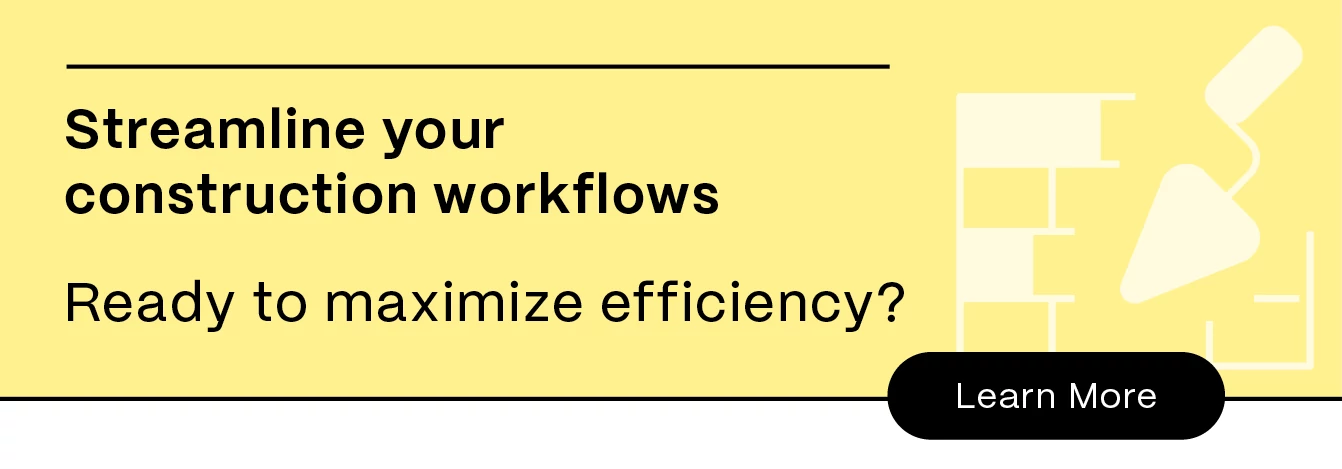
Blog
Master the construction bidding process: a complete guide

Construction spending in the U.S. topped $2.1 billion in May 2024, a nearly 9% increase from the same period last year. To capitalize on this growth, use the following guide to master the bidding process in the construction industry. From bid solicitation to project execution, read on to discover proven strategies and industry best practices for securing profitable projects.

What is bidding in construction?
Construction bidding is the competitive process where contractors submit proposals outlining the cost, timeline, and scope of work required for a construction project. It determines which contractor will be awarded the project. Bidding ensures fair competition, drives down project costs, and helps project owners select the most qualified and cost-effective contractor.
Types of construction bids
Understanding the different types of construction bids is crucial for contractors seeking to win projects. While the industry uses many different bidding methods, each requires a specific approach and strategy. Here are the most common:
Open tendering
Open tendering is when a project opportunity is publicly advertised for any interested contractor to submit a bid. This open competition aims to get the best price and contract terms available while ensuring fairness and transparency. However, drawbacks include the risk of low-quality bids and a time-consuming evaluation process.
This bidding type is best for government and large-scale projects, where significant cost savings can be achieved through increased competition.
Negotiated tendering
Negotiated tendering involves direct negotiations between a project owner and a selected contractor to determine the final contract terms and price. This approach is often based on the contractor's reputation, past performance or existing relationship with the owner.
Negotiated tendering often results in a faster process and stronger working relationships through proven trust. Drawbacks include less public transparency, the potential for favoritism, and less competitive pricing.
This bidding type is often ideal for urgent or complex projects that require specialized expertise and experience.
Selective tendering
Selective tendering is a bidding process where a project owner invites a select group of contractors to submit bids. This approach is based on pre-qualification, where contractors are chosen based on their reputation, experience or specific qualifications relevant to the project.
Benefits include more detailed, higher quality bids as well as a faster evaluation and award process. However, fewer bidders might result in higher prices and other qualified contractors getting overlooked.
Similar to negotiated tendering, selective tendering works well for highly specialized and time-sensitive projects.
Serial tendering
Serial tendering is used when a property owner seeks bids for a series of similar projects over a specific timeframe. It's a framework for pricing various elements of a project, allowing for quick cost estimations in the future.
This bidding process reduces the time and cost of preparing repeat bids and helps manage price fluctuations by locking in rates for a specific period. However, it is less adaptable and may encourage contractors to inflate rates to account for future uncertainties.
Repetitive projects, such as housing or apartment developments with predictable scopes and quantities, are best for this bid type.
9 key steps in the construction bidding process
Now that you understand the fundamentals of construction bidding and the various bid types, let's look at what the typical bidding process entails.
1. Bid solicitation
Bid solicitation is the first step in the construction bidding process, where a project owner invites contractors to submit bids. This involves creating and distributing bid documents, which outline the project scope, specifications, timeline, and other relevant details. Solicitation methods can vary, including request for proposals (RFPs), invitations to tender (ITTs), and requests for standing offers (RFSOs).
2. Bid estimating
Bid estimating forms the foundation of the bid that will be submitted to the project owner. Projected costs associated with a construction project are calculated based on a detailed analysis of materials, labor, equipment, subcontractors, overhead, and profit.
Accurate bid estimating is crucial for several reasons:
- Profitability: Affirms the bid is competitive while maintaining a reasonable profit margin.
- Risk management: Determines potential cost overruns to build contingencies into the bid.
- Decision-making: Provides essential data for determining whether to pursue a project or not.
- Contract negotiation: Strengthens the contractor's position during negotiations.
3. Bid submission
Bid submission is the formal presentation of a contractor's proposal to undertake a construction project. This involves compiling all necessary documents — such as the bid form, pricing schedule, project schedule, and any required bonds or insurance certificates — and submitting the proposal according to specified guidelines.
4. Bid opening
Bid opening is when submitted bids are publicly opened and read aloud. It typically occurs at a predetermined time and location specified in the bid documents. All interested parties, including contractors, subcontractors, and sometimes the public, may attend.
5. Bid evaluation
Bid evaluation is the critical process of assessing submitted bids to determine the best proposal. A thorough examination of each bid is done based on pre-established criteria, such as price, quality, experience, and compliance.
The bid evaluation stage is important because it helps project owners:
- Select the best contractor who can deliver the highest quality work within the budget and timeline.
- Mitigate the risk of project delays, cost overruns, and quality issues.
- Ensure fairness and transparency in the process for all bidders.
- Achieve cost effectiveness without compromising quality.
6. Contractor selection
Contractor selection is the process of choosing the winning bidder from the submitted proposals. Factors beyond the lowest price are evaluated, including the contractor's qualifications, experience, financial stability, and proposed project execution plan.
7. Negotiation and award
The negotiation and award stage is when the selected contractor and the project owner finalize terms and conditions. This often involves final discussions about contract price, scope of work, and payment terms. Once an agreement is reached, the contract is formally awarded to the successful contractor.
8. Commitment
Commitment is when the formal agreement between the project owner and the selected contractor is signed. It signifies a binding legal agreement between the parties. Necessary documents are exchanged and the project formally begins.
9. Project execution
Project execution is when construction work by the winning bidder takes place. This stage includes site preparation, material procurement, labor management, quality control, safety management, and overall project coordination. Its success directly impacts the project's overall outcome, such as its quality, budget, and schedule.
Construction bid management best practices
Ever wonder how to get construction bids that not only win projects but ensure profitability? Effective bid management is the key. This section outlines essential best practices that can enhance your bidding process, helping you stand out in a competitive market.
Develop a robust construction bid management process
A well-structured construction bid management process outlines clear roles, responsibilities, and workflows for your team. Consider implementing a dedicated construction project workflow management system to streamline tasks, improve collaboration, and enhance efficiency.
Related Read: Streamline your construction workflows

Master the art of bid qualification
Not every project is a good fit for your business. Effective bid qualification saves time and resources. Evaluate projects based on factors such as size, scope, location, client reputation, and your company's capacity and expertise.
Leverage construction bid templates
A construction bid template can significantly speed up the bid preparation process while ensuring consistency and accuracy. It should include components like project information, scope of work, pricing structure, terms and conditions, and company information.
Conduct thorough pre-bid site visits
Visiting the project site in person is essential for accurate estimating and risk assessment. Assess site conditions, identify potential challenges, and gather information for quantity takeoffs (QTO).
Build strong relationships with subcontractors
A reliable network of go-to subcontractors is helpful for competitive bidding and successful project execution. Develop long-term partnerships, maintain open communication, and establish clear expectations.
Use advanced estimating software
Construction estimating software can streamline construction bid management, improve accuracy, and enhance productivity. Look for features like QTO, material pricing, labor estimating, and bid proposal generation.
Develop a strong bid proposal
A compelling bid proposal can differentiate your company from competitors. It should include a clear project understanding, detailed scope of work, competitive pricing, strong qualifications, and persuasive writing.
Continuously analyze bid performance
Tracking bid win rates, project profitability, and KPIs (key performance indicators) is essential for continuous improvement. This process also helps optimize bidding strategies and enhance overall business performance.
Construction project: workflow automation for bid management
The construction industry is ripe for digital transformation. Manual processes, paper-based workflows, and siloed information often hinder efficiency and profitability. By automating the construction bid management process, you can streamline operations, improve accuracy, and gain a competitive edge.
A construction project workflow solution should offer the following features:
- Centralized document management: Securely store and manage all project documents, including blueprints, specifications, and bid proposals, in a centralized location.
- Real-time collaboration: Enable seamless collaboration among team members, subcontractors, and clients, regardless of location.
- Automated workflows: Streamline repetitive tasks, such as bid distribution, document approval, and bid submission, to reduce errors and save time.
- Bid tracking and analysis: Monitor bid progress, compare bids, and identify trends to inform decision-making.
- Integration capabilities: Optimize data flow and eliminate manual data entry by connecting with other construction software applications.
- Mobile accessibility: Provide on-the-go access to project information and the ability to approve documents or submit bids from anywhere.
- Robust security: Protect sensitive project data with advanced security measures. Without a secure sharing process, competitors could access your documents and view things like pricing or intellectual property.
Master construction bidding for long-term success
To successfully secure construction projects, you need a deep understanding of the bidding process and take a strategic approach. From bid submission to landing the project, every stage offers opportunities to increase competitiveness and profitability.
Leveraging technology to streamline workflows and improve collaboration is essential. By using the right solutions and implementing best practices for construction bid management, you can position your business for long-term success. The ultimate goal is not only to win projects, but secure profitable ones that contribute to your overall growth.
Related Resources
